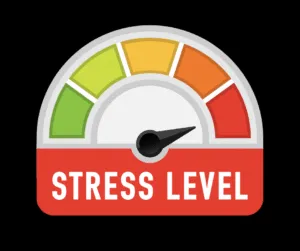Stress manifests in various ways. For humans, it might look like biting your nails during a high-stakes meeting, endlessly scrolling through social media, or stress-eating an entire pizza when all you intended was “just a slice.” For our canine companions? Well, stress might take the form of a meticulously planned military operation to break out of their crate as if it were Alcatraz.
If you’ve ever returned home to find your dog lounging on the couch, crate door ajar (or entirely dismantled), sporting that unmistakable “Who, me?” expression, then this article is for you. When your Dog Tries To Break Out Of Crate, it’s often more than just a desire to stretch their legs. It’s a clear signal that something deeper is at play, and it’s time to delve into the inner workings of their furry little minds to understand what’s truly going on.
 Husky dog looks out from a secure crate, potentially showing signs of wanting to escape.
Husky dog looks out from a secure crate, potentially showing signs of wanting to escape.
My Personal Crate Breakout Chronicles
Let me introduce you to Max. Max was a Husky mix—big, fluffy, and undeniably too smart for his own good. His crate? It was a beautifully designed, heavy-duty, “indestructible” fortress. It cost more than my first car, but I convinced myself it was a worthy investment for a dog that needed a peaceful spot to relax and recharge. Plus, countless dog blogs assured me that crate training would be my shield against canine chaos. Spoiler alert: for Max, it was not.
The first time Max managed to break out of his crate, I wasn’t overly concerned. I assumed I hadn’t latched it properly. After all, who could blame a guy for wanting to enjoy the comforts of the house while I was out? But then it happened again, and again… and then again. One afternoon, I arrived home to find the crate door hanging precariously by a single hinge, Max’s cozy blanket shredded across the living room floor like confetti after an epic celebration. Max himself? He was sitting there, completely unbothered, looking as though he was about to queue up his favorite show on Netflix.
It was the day I truly realized this wasn’t merely a “crate problem.” It was a Max problem—and perhaps, just perhaps, it was a “me problem” too. Understanding why a dog tries to break out of crate requires looking beyond the immediate behavior.
 A yellow Labrador retriever dog calmly resting after successfully escaping its crate.
A yellow Labrador retriever dog calmly resting after successfully escaping its crate.
The Hidden Psychology Behind Crate Breakouts
Let’s be clear: when your dog channels their inner Houdini to escape their crate, it’s rarely just about physical escape. It’s fundamentally about stress. And no, I’m not referring to the mild annoyance that comes from barking at the mail carrier or realizing their favorite toy rolled under the sofa. This is what I like to call “existential dog stress.” Yes, that’s a real phenomenon.
Crate breakout behavior is frequently rooted in anxiety. Dogs can feel profoundly trapped, both physically and mentally, within crates—especially if they begin to associate the crate with isolation or punishment. Dogs are inherently social creatures, and if they perceive themselves as being “banished” from their human pack, they may start diligently plotting their grand escape. It’s their unequivocal way of communicating, “I cannot cope with this alone!” When a dog tries to break out of crate, it’s a cry for help.
And here’s where the irony comes into play: the very crate that’s intended to be a calming, safe haven might, in fact, be the primary source of their greatest stress. It’s akin to humans trying to “relax” by tuning into the evening news—instant stress surge, right?
 An anxious dog looking sad inside a crate, highlighting the stress dogs experience when trying to break out.
An anxious dog looking sad inside a crate, highlighting the stress dogs experience when trying to break out.
What Your Dog is Really Telling You: Decoding Their Crate Escape
You see, dogs are constantly attempting to communicate with us. While they may not use spoken words, they make it abundantly clear when something is amiss—provided you know how to interpret their signals. The crate breakout? That’s the canine equivalent of a passive-aggressive email sent at 2 AM. Let’s decode the messages they’re truly sending when a dog tries to break out of crate.
“I’m Lonely, Dude.” – Addressing Separation Anxiety
The most common underlying cause of crate breakouts is separation anxiety. If your dog isn’t accustomed to being away from you, they are likely to experience intense distress when confined. Much like how you might “freak out” when your phone dies and you’re left alone with only your thoughts. A breakout might be their frantic way of saying, “Hey, I can’t do this. Where did you go?”
“This Space Feels Like a Jail Cell.” – Claustrophobia & Confinement
Some dogs genuinely experience claustrophobia. It’s not necessarily about whether the crate is too small (though that certainly could be a contributing factor). It’s about the overwhelming sensation of feeling confined, as if they’ve been sentenced to solitary confinement without a fair trial. They’re pleading, “I need more space to breathe, man!”
“I’m Bored Out of My Mind.” – The Need for Mental Stimulation
Dogs are much like energetic toddlers. They require consistent mental and physical stimulation. When they are left in a crate with nothing engaging to do, they will inevitably find ways to entertain themselves—and by that, I mean they’ll initiate chewing, digging, and meticulously plotting their escape route. This is their version of texting you at work asking, “When are you coming home? I’m incredibly bored!”
“I’m a Free Spirit, Okay?” – When Crates Just Aren’t a Fit
For some dogs, regardless of your best efforts, a crate will simply never feel like their happy place. No matter how much positive reinforcement you use, they’ll perceive the crate as an obstacle in their unyielding quest for freedom. They will dedicate their time and energy to figuring out how to get out—think “Shawshank Redemption,” but with more fur and fewer rock hammers.
 A lonely puppy inside a crate with toys, illustrating reasons why a dog tries to break out of crate due to boredom or separation.
A lonely puppy inside a crate with toys, illustrating reasons why a dog tries to break out of crate due to boredom or separation.
Practical Strategies to Manage Your Dog’s Crate Stress
Here’s the good news: you are definitely not alone in facing this challenge. There are effective ways to manage your dog’s stress (and, consequently, your own) when it comes to persistent crate breakouts. Here’s a brief, essential guide on how to approach the situation without immediately resorting to purchasing an even more heavy-duty, escape-proof crate.
Start with Your Own Calm: The Human-Canine Connection
First things first: take a deep breath and relax. Stress is highly contagious, and if you are frazzled, your dog will undoubtedly pick up on your anxiety. If they are breaking out of their crate, resist the urge to panic. Do not immediately assume they are being disobedient or intentionally trying to “get back at you.” They are simply trying to communicate that something is profoundly wrong.
Reevaluate the Crate Setup: Size, Comfort, and Location
Not all crates are designed equally, and not all dogs respond to them in the same way. Perhaps your dog genuinely requires a larger crate, or a significantly softer, more inviting bed. Maybe they would benefit from a crate that feels more open and den-like, rather than a solid, plastic fortress. Sometimes, even a minor rearrangement of the crate’s location can make a substantial difference.
Gradually Ease Separation Anxiety: Positive Reinforcement & Gradual Exposure
If separation anxiety is identified as the primary culprit, focus on gradually acclimating your dog to periods of alone time. Begin by leaving them in the crate for very short durations, then slowly and incrementally increase the time. Crucially, pair crate time with positive reinforcement—think high-value treats, engaging toys, or calming music specifically designed for dogs. It’s like providing them with their favorite streaming service while you’re out.
Boost Mental & Physical Enrichment: Puzzle Toys & Exercise
If boredom is the underlying issue, it’s imperative to provide your dog with ample activities. Interactive puzzle toys, durable chew toys, and Kong toys generously stuffed with irresistible treats can keep them mentally stimulated and physically occupied. This is the canine equivalent of handing a child an iPad on an exceptionally long car ride.
When to Seek Professional Help: Trainers & Behaviorists
If your dog’s stress levels appear extreme, or if their breakout behavior persists despite your best efforts, it might be time to call in professional reinforcements. A certified professional dog trainer or a veterinary behaviorist can help you accurately identify the root cause of your dog’s anxiety and develop a comprehensive game plan tailored to address it effectively.
 Owner comforts their dog inside a crate, demonstrating positive reinforcement to manage anxiety and prevent escape attempts.
Owner comforts their dog inside a crate, demonstrating positive reinforcement to manage anxiety and prevent escape attempts.
The Profound Truth: It’s Not Always About the Crate
Ultimately, the profound and often ironic truth is that dogs, much like humans, are consistently trying to communicate something vital when they are under stress. As their devoted human companions, our role is to accurately decipher what that message is.
Max? Well, after a period of intense trial and error (and a few more memorable crate breakouts), I came to a pivotal realization: his anxiety wasn’t just about the crate itself. It was, in many ways, about me. He lacked the fundamental skills to self-soothe, to relax, and to effectively control his emotions when I wasn’t physically present, within his sight, smell, or hearing.
I won’t deny it—it was a humbling experience to recognize that I had been so singularly focused on “training” Max to be crate-friendly that I had entirely missed the deeper, underlying point. Sometimes, when a dog tries to break out of crate, it’s not about the crate at all. Sometimes, it’s about the intricate emotional landscape within the dog’s mind, and their unspoken need for connection and coping mechanisms.
 A contented dog relaxing outside its open crate, showing the positive outcome of understanding why a dog tries to break out of crate.
A contented dog relaxing outside its open crate, showing the positive outcome of understanding why a dog tries to break out of crate.
Conclusion
So, the next time you arrive home to discover yet another masterful crate escape, resist the urge to simply shake your head in disbelief or frustration. Instead, take a moment to pause and ask yourself: what is my dog genuinely trying to convey to me? Because behind that daring jailbreak lies a much deeper narrative—one about connection, trust, and, indeed, effective stress management. After all, we’re all just striving to manage our stress, one breakout at a time, and understanding your dog’s signals is the first step towards a calmer, happier coexistence. For more expert insights and personalized dog training tips, visit Dog Care Story.
